My Unrecognizable Hometown
Living in the Burnt-out Ruins
Sasaki did not point his camera at people who were suffering from injuries immediately after the A-bombing. However, from autumn 1945 he came to focus more on people's lives with his photographs. The barracks that were built in the ruins, and the station plaza crowded with demobilized soldiers and citizens who were going to procure food, show signs of reconstruction even in the midst of such a tragic situation.
 |
 |
Washing clothes on a street
1945
Nakajima-hon-machi (now, Nakajima-cho, approx. 200m from the hypocenter)
A woman washing clothes with water from a broken water pipe in front of Fuel Hall on the west end of Motoyasu Bridge. For some time after the A-bombing, water pressure dropped due to water leakage, resulting in no water coming out of water taps.
|
 |
 |
 |
 |
 |
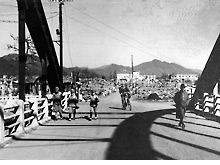 |
|
Yokogawa Bridge
1945
Yokogawa Bridge (approx. 1,300m from the hypocenter)
View looking north, in the direction of Yokogawa Station, from the central area of Yokogawa Bridge. The white building in the center is the Hiroshima City Credit Union Headquarters. Junior high school students carrying shovels on their shoulders might have been heading toward a clearing operation in the burnt ruins.
|
|
|
| |
|
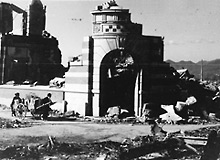 |
|
Transferring household goods with a cart
1945
Tsukamoto-cho (now, Sakai-machi 1-chome, approx. 480m from the hypocenter)
A woman pulling a cart loaded with household goods and a child. The building behind was the brick-built Tsukamoto-cho Branch of Geibi Bank, which was seriously damaged by the blast, leaving the entrance and parts of some walls unburned.
|
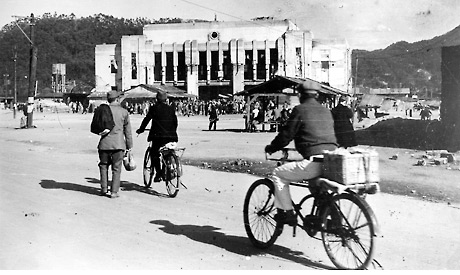 |
|
In front of Hiroshima Station
1945
Matsubara-cho (approx. 1,900m from the hypocenter)
Even after train services restarted, fewer trains were in service due to a lack of coal. To prioritize the transfer of demobilized soldiers and repatriates, services for the public were restricted. There was a long line of people in front of Hiroshima Station consisting of people trying to travel to the suburbs for food, and people coming into the city.
|
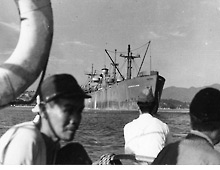
Demobilized soldiers arriving at Hiroshima Port
1946
Hiroshima Port (Ujina Port)
Demobilized soldiers arriving at Hiroshima Port via American ships. What would they have thought seeing their hometown changed beyond recognition after finally arriving at the port?
|
|
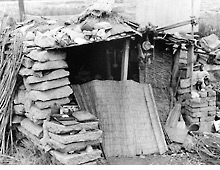
House made of stone and tin roofs
1948
Near Hiroshima Station
A house made of paving stone from a streetcar rail track and burned galvanized plates. Tableware and kitchen utensils placed in the area of the entrance are signs of somebody living there.
|
|
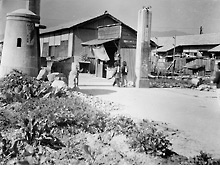
Public housing built on former military land
1949
Moto-machi
Public housing built on the former site of the 5th Field Artillery Regiment. From 1946 to spring of 1948, Hiroshima City and the Housing Corporation constructed approximately 2,000 residences for A-bomb victims and returnees, only allowing a few of those who had lost their homes to move in.
|







